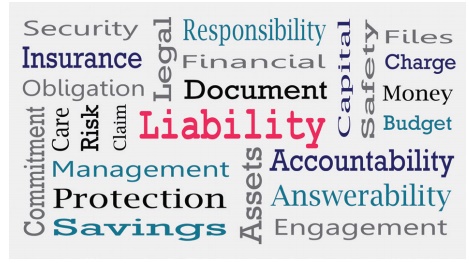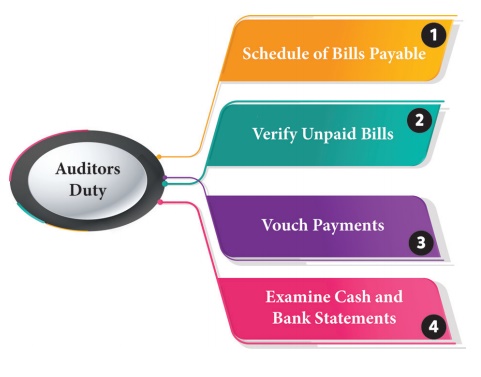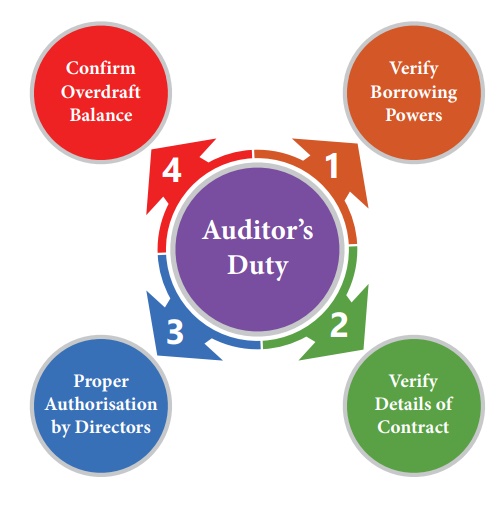Auditing - Verification of Current Liabilities | 12th Auditing : Chapter 6 : Verification of Liabilities
Chapter: 12th Auditing : Chapter 6 : Verification of Liabilities
Verification of Current Liabilities
Verification of Current Liabilities

Current
liabilities are those liabilities which are payable within one year. This
includes bank overdraft, sundry creditors, bills payable and outstanding
expenses.
1. Sundry Creditors
MEANING
A person
who gives a benefit without receiving money or money’s worth immediately but to
claim in future is a creditor. The creditors are shown as a current liability
in the Balance Sheet.
AUDITOR’S DUTY
1. Verify Books of Prime Entry:
The
postings in purchase ledger are to be checked by verifying the books of prime entry.
The postings may be checked for part of a year.
2. Verify Statement of Accounts:
The
balances shown in credit of suppliers account are to be verified with the
statement of accounts obtained from the creditors.
3. Verify Credit Entries:
The
credit entries relating to discounts, returns, rebates etc. made in the
suppliers account are to be verified with the statement of accounts obtained
from them.
4. Accounting of Purchase Returns:
The
return outwards book is to be compared with the ledger accounts and confirm
that all the returns are supported by the credit notes of the suppliers.
5. Purchases of Subsequent Year:
The
purchase invoices relating to the period immediately following the close of the
year, are to be verified to ensure that they do not relate to the period under
audit.
6. Obtain Reasons for Outstanding Balance
The
balances outstanding for a long period is to be probed and reasons for the same
are to be found out.
7. Comparison of Gross Profit:
Percentage
of gross profits of the previous years is to be compared with the gross profits
of the year under audit. Variation if any, found to be unreasonable or omission
of purchase or inclusion of fictitious purchases are to be considered.
8. Confirmation from Management
The
auditor shall obtain from the management a certificate that all liabilities
that had accrued till the close of the accounting year are carefully accounted
for.
2. Bills Payable
MEANING
Bill
refers to bill of exchange. Bills payable means bills acccepted for the credit
purchases made. The amounts on bills are payable at the due dates. It is a
current liability.
AUDITOR’S DUTY
1. Schedule of Bills Payable: The
auditor should get a schedule of
bills payable and compare with the Bills Payable Book and Account.
2. Verify Unpaid Bills: He
should verify unpaid bills and check
the subsequent payments with the cash book.
3. Vouch Payments: He should vouch the payments made against bills payable.
4. Examine Cash and Bank Statements: He
should examine cash and bank statements for the bills which are met after the
date of Balance Sheet but before the date of audit.

3. Bank Overdraft
MEANING
It is a
line of credit extended by a bank to its account holder to withdraw money in
excess of the balance in his account up to a specified limit. It is a current
liability as the business concern, i.e., being an account holder is liable to
repay the amount to the bank.
AUDITOR’S DUTY
1. Verify Borrowing Powers: The
auditor should examine the
Memorandum and Articles of Association to know the borrowing powers of the
company.
2. Verify Details of Contract: He
should study the loan contract,
terms and conditions of loan, rate of interest, nature of security, type of
pledge, etc.
3. Proper Authorisation by Directors: He should refer the minute book of
directors to know the bank overdraft is duly authorised.
4. Confirm Overdraft Balance: He
should confirm the amount of
overdraft from the bank at the close of the year.

4. Outstanding Expenses
MEANING
Expenses
which have been incurred but not yet paid during the accounting period for
which the final accounts are being prepared are called as Outstanding Expenses.
AUDITOR'S DUTY
1. Verify list of Outstanding Expenses: The
auditor should ask for a list of outstanding expenses certified by a
responsible officer from the client with classification as per the nature of
expenses.
2. Very Cash Book: He should check the next year cash book to confirm that
they have been paid off by the time of audit.
3. Compare Expenses with Previous year: He
should compare the list of outstanding
expenses of the current year with that of the previous year to identify
deviations, if any.
4. Verify Provision Created: He
should see whether necessary
provision for all outstanding expenses has been made by checking relevant
receipts and vouchers.
Related Topics